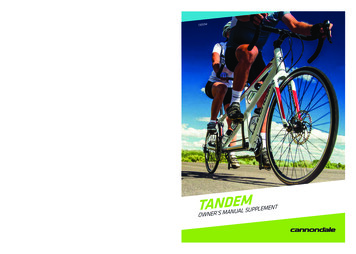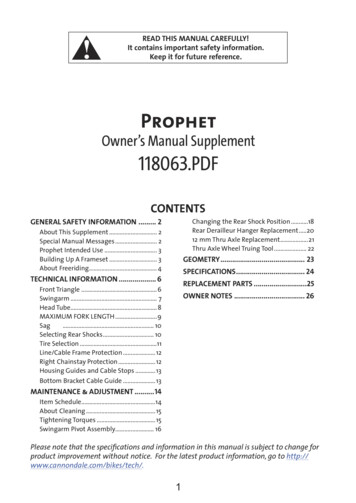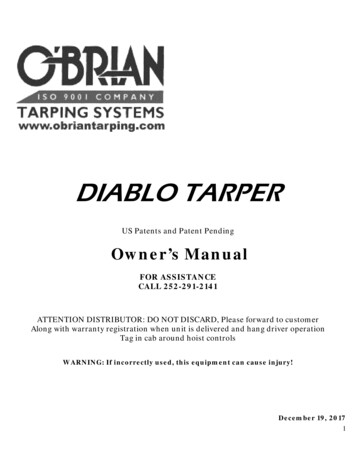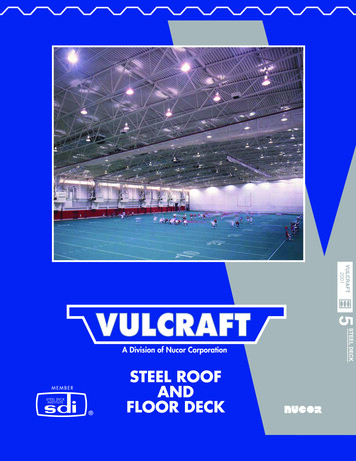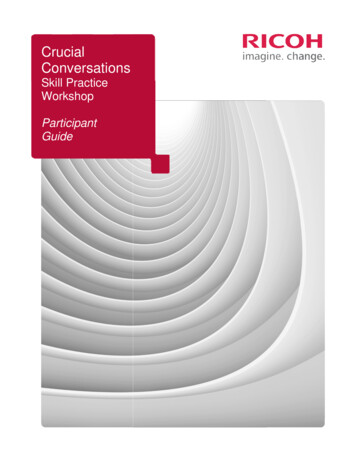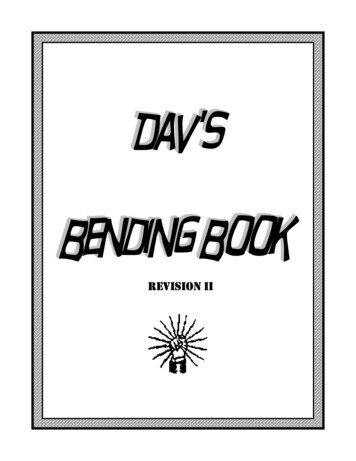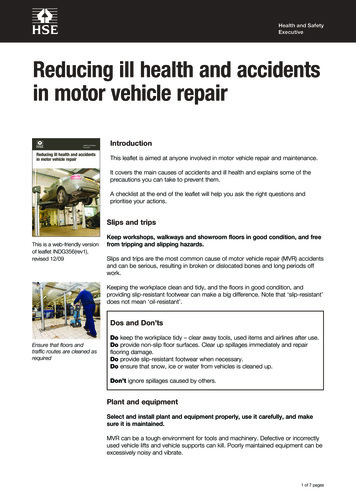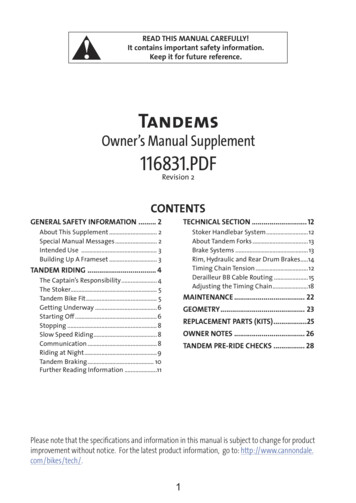
Transcription
READ THIS MANUAL CAREFULLY!It contains important safety information.Keep it for future reference.TandemsOwner’s Manual Supplement116831.PDFRevision 2CONTENTSGENERAL SAFETY INFORMATION . 2TECHNICAL SECTION . 12About This Supplement . 2Special Manual Messages . 2Intended Use . 3Building Up A Frameset . 3Stoker Handlebar System .12About Tandem Forks . 13Brake Systems . 13Rim, Hydraulic and Rear Drum Brakes.14Timing Chain Tension .12Derailleur BB Cable Routing . 15Adjusting the Timing Chain .18TANDEM RIDING . 4The Captain’s Responsibility . 4The Stoker. 5Tandem Bike Fit . 5Getting Underway .6Starting Off .6Stopping . 8Slow Speed Riding . 8Communication . 8Riding at Night .9Tandem Braking . 10Further Reading Information .11MAINTENANCE . 22GEOMETRY . 23REPLACEMENT PARTS (KITS) .25OWNER NOTES . 26TANDEM PRE-RIDE CHECKS . 28Please note that the specifications and information in this manual is subject to change for productimprovement without notice. For the latest product information, go to: http://www.cannondale.com/bikes/tech/.1
Special Manual MessagesGENERAL SAFETYINFORMATIONIn this manual, information which affectsyour safety is emphasized in the followingways:The Safety Alert Symbolmeans :“ATTENTION.BECOMEALERT, YOUR SAFETY IS INVOLVED.”About This SupplementCannondale Owner’s Manual Supplementsprovide important model specific safety,maintenance, and technical information.They are not replacements for your Owner’sManual.WARNINGA WARNING indicates a potentiallyhazardous situation which, if not avoided,can result in serious injury or death.This supplement may be one of several foryour bike. Be sure to obtain and read all ofthem.WARN000If you need a manual or supplement, or havea question about your bike, please contactyour Cannondale Dealer immediately, orcall us at one of the telephone numberslisted on the back cover of this manual.CAUTIONA CAUTION Indicates a potentiallyhazardous situation which, if notavoided, can result in serious damageto the product. The matters describedunder CAUTION may, if not avoided, leadto personal injury, or results dependingon the situation and degree of damage.Important matters are described inCAUTION (as well as WARNING), so besure to observe them.You can download Adobe Acrobat PDFversions of any Cannondale Owner’sManuals or Supplements from our website.Go to: http://www.cannondale.com/bikes/tech This manual is not a comprehensive safetyor service manual for your bike. This manual does not include assemblyinstructions for your bike.CAUT000 All Cannondale bikes must be completelyassembled and inspected for properoperation by a Cannondale Dealer beforedelivery to the owner.NOTE:A NOTE provides helpful information ortips intended to make the informationpresented clearer.* * IMPORTANT * *This manual may include proceduresbeyond the scope of general mechanicalaptitude.Special tools, skills, andknowledge may be required.If you have any doubt about your abilityto properly inspect, adjust, or serviceyour bicycle, do not attempt to performthe work described; please take the forkto a Cannondale Dealer.2
116831.PDFIntended UseBuilding Up A FramesetRoad Tandems:Consult with your Cannondale Dealer andthe component manufacturers and franklydiscuss your riding style, ability, weight, andinterest in and patience for maintenance.Are designed to be ridden on paved roads,hard dirt or gravel roads only. They are notdesigned for mountain biking or off road use.Cannondale road tandems are designed fortouring with racks and panniers.Generallyspeaking, lighterweightcomponents have shorter lives. In selectinglightweight components you are making atrade-off, favoring the higher performancethat comes with less weight over longevity.If you choose more lightweight componentsyou must inspect them more frequently.If you are a heavier rider or have a rough,abusive or “go for it” riding style, buy heavyduty components.Mountain Tandems:Are designed as mountain bikes and may beridden off road in easy to moderate terrain.The challenges of mountain biking areobvious, but outlined in PART II, Section Cof the Cannondale Bicycle Owner’s Manual.The added challenges of tandem riding,many of which are outlined in this ownersmanual supplement mean that you shouldlimit off road tandem riding to easy moderate terrain.Make sure the components chosen arecompatible with your bike and intended foryour weight and riding style.Read and follow the componentmanufacturers warnings and instructions.WARNINGUsing yourhazardous.bicycleimproperlyisWARN0013
TANDEM RIDINGCAPTAIN(Matt)STOKER(Lauren)A ROAD TANDEMFigure 1 - Captain and Stoker on a Road TandemTandems are fun, and with two engines for the same frontal area, they’re considerablyfaster than single bikes. Tandem teams learn to ride together well, to communicatewithout words, and to anticipate each other’s desires. Tandeming is a great way to enjoycycling with another person.Tandems are serious business too. One rider (THE CAPTAIN) is entirely responsible for thewell-being of the other rider (THE STOKER). The bike is bigger, heavier, and less forgiving ofsloppy riding habits. A tandem captain can’t be as spontaneous as a rider on a single, norcan the captain make the same kinds of last-minute recoveries from errors in judgment.Look farther ahead, plan farther ahead.Also, be aware that tandems attract attention. People will stare, wave, shout. Passing cars,temporarily distracted, will often swerve in or out. The presence of a tandem can makepeople act differently on the road. A bell or air horn can be very handy in traffic.4
116831.PDFWARNINGTANDEMS ARE BIGGER, HEAVIER, AND LESS MANEUVERABLE THAN SINGLE RIDER BIKES. Ride very cautiously as your team climbs the tandem learning curve. More time is needed to react and avoid ride hazards. Always think further ahead. Allow more time. Learn to anticipate hazards.Tandem riding, like any bicycle riding carries a risk of serious injury, paralysis or death.WARN002The Captain’s ResponsibilityThe captain’s primary job is to make the stoker happy. With an unhappy stoker, the captainwon’t have a riding partner! So you must reassure your partner with careful, methodicalriding habits. Anticipate maneuvers, beginning them far in advance. Be alert to shiftingneeds. A too-fast or too-slow cadence is doubly annoying to the stoker because she/hecan’t fix it. Watch the road or trail ahead, and make your steering and braking correctionssmoothly.Ride slightly farther from the curb, or from parked cars, than you would on a single bike.Your stoker doesn’t want to feel hemmed in. If you ride too far to the right, you may findyour stoker leaning to the left, trying to veer away from the curb.When you conduct a maneuver, such as merging across traffic to make a left turn orsteering around a pothole, make your decision early. Signal your intentions clearly, proceedon a straight path, and complete the maneuver. A decisive captain will ride smoother, andthat will make the stoker happier.Most new tandemists find captaining exhausting, and they get sore shoulder musclesfrom being tense. This too will pass. As you become accustomed to the requirements ofcaptaining a tandem, you’ll develop a light touch.Don’t hot dog. If your stoker is nervous, ride slowly. In time, the stoker may become moreconfident and ask for more speed. But if she/he wants to go slow, go slow! The moreconservative voice must prevail. That’s only fair. Remember, you’re the chauffeur, not thestunt pilot.5
The Stoker : The Best Seat in The HouseThe back seat on a tandem is the fun seat. You have this person in front of you who’sgiving all his/her attention to making you feel comfortable. The view is terrific out to thesides, just like on a train ride. The view to the front may be a bit bland, but the captain’sjersey pockets are a great place to put your binoculars, camera, radio, fruit bars, and otherhedonistic goodies.Your obligations are few: Pedal—at an agreed-upon effort level. Pedal smoothly, so yourpedaling doesn’t make your upper body move around. Don’t shift your upper body weightabruptly. (Your weight shift can inadvertently steer the bike, and force the captain to fightyou.) Hold your head high and enjoy the scenery. Tell your captain what she/he is missingwhile she/he keeps eyes glued to the road for potholes.Many tandem teams delegate hand turning signals to the stoker. This not only encouragescommunication between the stoker and the captain, it also allows the captain to concentrateon the steering and braking involved in making the maneuver.Every successful stoker learns to delegate authority. The captain steers. The captain decideswhen to pedal and when to coast. When coasting, the captain decides where to positionthe pedals. Never fight the captain on these matters. She/he is busy giving you a great rideso you can enjoy yourself.Tandem Bike FitIn addition to sizing and comfort issues for each individual, the bicycle must be madeto accommodate the interaction between the two riders. This document is meant tooffer hints and suggestions but only scratches the surface of tandem setup. The bestconfiguration for any pair of cyclists on a tandem will be the result of experimentation. Youshould investigate the pros and cons of any setup decisions by first consulting with peopleor publications which are knowledgeable about tandem bicycles. See page 9.The captain should fit the tandem as she/he would fit on a single bike. But on a tandem,it’s doubly important to have 2-3 inches of crotch clearance for the starting and stoppingmaneuvers described earlier.The stoker uses the same seat-to-pedals distance as on a single bike. But the handlebarswill be closer (which is okay, since the stoker doesn’t need to steer).6
116831.PDFGetting UnderwayAllow time for a complete pre-ride inspection. See the back cover of this manual forTandem specific Pre-Ride Checks and the back cover of your Cannondale Bicycle Owner’sManual for overall bicycle pre-ride checks.Starting OffStarting and stopping a tandem is smooth and easy, but only if you do everything in theexact prescribed order. Start by shifting the bike into a comfortably low gear.The captain mounts first. Before, and only before anyone gets on the bike, it can be leanedover to lower the clearance to straddle the bike. Swing your leg forward over the handlebars,not back over the rear of the bike. There might be a person standing there!) Straddle thetop tube, plant your feet on the ground, and spread your legs to clear the pedals. Firmlyhold the bike upright and squeeze both brakes.Never let the bike lean to the side, particularly after the stoker gets on. This is the biggestdifference between your tandem and your single. (Your single is so light that you don’tthink twice about leaning it. The tandem is not only heavy, it’s top heavy. Once you let itlean a little, the stoker’s weight makes it want to lean more. And the stoker just hates theway that feels.)The stoker gets on now. Because the captain is holding the bike rock solid, the stoker canmount it like a horse. Put one foot on a pedal and swing your other leg rearward over thesaddle. Now the stoker puts both feet in the toe clips or clipless pedals. When you’re ready,backpedal so the captain’s preferred starting pedal is in the up position. Say “ready.”Now the captain can start. Pick up one foot, put it on a pedal, and stand on it while steeringstraight ahead. (Don’t put your rear end on the seat before starting to pedal, because thatcould make the bike lean over and wobble, and possibly fall.) After you’ve started thefirst pedal stroke, get in the saddle, put your other foot on the backside of the pedal, andcontinue pedaling and steering. Don’t worry about the toe clip or clipless pedals. Let thetoe clip scrape the ground. Pedal until you are going comfortably fast (10 mph or so), andthen put your other foot in the toe clip or clipless pedals.7
StoppingIf you stop briefly, say, for a traffic light, the captain stops the bike while the stoker staysstrapped in. The captain takes one foot off the pedal, dismounts from the seat, and putsthe foot on the ground while holding the bike absolutely upright. Starting up again is justlike your initial start-up. The captain should let the stoker know what’s happening —talkto one another —no surprises.To stop and dismount, reverse the mounting procedure. The captain gets off the seat,spreads legs to clear the pedals and brace the bike upright while the stoker climbs off. Thenthe captain can dismount.Slow Speed RidingTandems are stable and easy to maneuver at slow speeds. But they need a confident captainwho doesn’t overcorrect or induce wobbling. A smooth style is the key to good slow-speedriding. After you’ve gotten to know your tandem well, you’ll find you can make a U-turn ona narrow two-lane road.CommunicationSome tandem teams talk a lot about riding. They inform each other of every bump, everyshift, every time they slow down, every drink from a water bottle. Others almost never talk.They prefer to communicate silently. Whichever style you pick is up to you. Just pick theone that works for you.One important coordination activity may require talking, at least at first: shifting. Thereason: on a single bike, riders intuitively let up on the pedals when they’re shifting. On atandem, the stoker doesn’t necessarily do that. This is hard on derailleurs (especially frontderailleurs) and may make shifts more difficult. Make sure you both let up on the pedalsduring critical shifts. Whether you do that by talking or by the stoker feeling when captainis about to shift is up to you.WARNINGGOOD COMMUNICATION BETWEEN THE CAPTAIN AND STOKER INCREASES THE SAFETYAND ENJOYMENT OF THE RIDE. MISCOMMUNCIATION OR POOR COORDINATIONINCREASES THE CHANCE OF BEING INVOLVED IN AN ACCIDENT.NEW TANDEM RIDERS:Before riding on a more challenging course, choose an open area free of hazards topractice and develop good Tandem communication skills.WARN0038
116831.PDFRiding at NightMost of tandem safety comes from good technique, which we’ve described above. A fewspecific warnings merit mention, though.Riding a tandem at night is legal if you have a headlight and taillight— but we don’trecommend it. Nighttime riding is more mentally demanding than day time riding.Tandem riding is more mentally demanding than single riding. A tandem at night adds upto too much demand, and too small a margin for error. A tandem is a pleasure vehicle, souse it during day—the most pleasant time to ride.See your Cannondale Bicycle Owner’s ManualFor more important safety information on riding at night.9
Tandem BrakingTandems can stop shorter than single bikes on pavement.The reason: a single bike’s braking performance is limited by the physics of pitching therider over the front wheel. The tandem has the stoker’s weight to hold the rear wheeldown, so pitchover doesn’t apply.The tandem’s braking force on pavement is limited by the friction between the tire andthe road. How great is that? It depends on the road and the tire, and there’s no way tomeasure it. Since you don’t want a front-wheel skid, don’t be too bold. On good pavement,you can stop slightly more abruptly than you would on a single bike. Remember to gaugethis by the feeling of deceleration, not by the brake hand lever effort. On poor pavement,unpaved surfaces, sand, oil, or any other debris, brake gingerly. Slow down—drastically—before you reach such surfaces.Tandems, like singles, get most of their braking force from the front wheel. The rear wheelis more prone to skidding. The left hand lever normally controls the front brake. Applyfront braking more than the rear brake for maximum stopping power. Brake before turns,not in them. If you must brake in a turn, do it with the rear brake.Tandems are much faster than singles on downhills: GO SLOW and control your speed.WARNINGWHEN DESCENDING A LONG DOWNHILL, APPLY YOUR FRONT AND REAR BRAKESTOGETHER IN AN “ON AGAIN, OFF AGAIN” METHOD ALLOWING BRIEF PERIODS INBETWEEN FOR THE BRAKE SYSTEM TO COOL. WHY? READ ON.When used for long periods of continuous braking in mountainous terrain, rim brakeswill heat the rims. Heat build up in the rim can overheat the air in the inner tube, possiblyresulting in a tire blowout.During long downhill descents in mountainous terrain, there is a risk that hydraulicbrake systems will fade or lessen braking force as heat grows in the pads, fluids, andcalipers from friction. Under extreme conditions, your brakes could fade or “fade-out”completely. You can be severely injured, paralyzed as a result.NOTE : All Cannondale Tandem bike frames can be fitted with a rear drum brake (suchas Arai ). Rear drum brakes can be used as drag brakes to control speed such as on longdownhill descents. Drum brakes are capable of dissapating heat without affecting othersystems. A drum brake can be set up in addition to rim brakes. Please consult with yourCannondale Dealer or shop to help you select and install a rear drum brake system. Seepage 14 for more information.WARN00410
116831.PDFFurther Reading & Information:This supplement can’t cover everything you might want to know about tandeming. Foradditional information on riding technique, we suggest you contact: Tandem Club of America, c/o Jack & Susan Goertz, 2220 Vanessa Dr., Birmingham, AL35242, 205-991-7766, e-mail: tca of a@mindspring.com.Their magazine, Doubletalk, and attendance at TCA events will make you an expert.Besides, TCA events, such as the various regional tandem rallies, are lots of fun. Local tandeming/bicycling clubs in your area have many helpful people. Ask yourAuthorized Cannondale retailer to put you in touch with them. The Tandem Scoop, the only book about tandeming we know of, contains extensiveinstructions on smooth technique, racing, touring, and dirt riding, riding with children,blind and disabled stokers, and other subjects. (By John Schubert, published by BurleyDesigns, Eugene, Oregon, 1996. Paperback, 9. ISBN 0-9637190-0-9) The Tandem Book, The Complete Guide to Buying, Riding and Enjoying TandemBicycles. (By Angel Rodriguez and Carla Black, 14.95, available from Adventure Cycling,800-721-8719 8am.-5pm. M-F Mtn. Time, or www.adv-cycling.org)11
TECHNICAL INFORMATIONStoker Handlebar SystemThe Stoker’s handlebar is attached to the bike on the Captains seat post. It is importantto ensure that the attachment is always secure and that the Stoker’s handlebar stemextension is properly installed and tightened.“MINIMUM INSERT” or“MAXIMUM EXTENSION” lineSTOKER’SSTEM-TO-SEATPOSTCLAMP BOLTSCAPTAIN’SSEAT POSTCLAMP BOLTSTOKER’SHANDLEBARCLAMP BOLTSFigure 2 - Stoker Handlebar SystemBefore every ride:1.Inspect the Captains seat post make sure it is in good condition and installedproperly.2.Inspect the Stoker’s handlebar system. Make sure it is in good condition and attachedsecurely to the Captain’s seat post. If it is the type that can be extended, be sure itis not extended beyond the “MINIMUM INSERT” or MAXIMUM EXTENSION” line.Also, make sure the Stoker’s handlebars will not rotate or move. Tighten all bolts torecommended torque when necessary.SEE YOUR CANNONDALE BICYCLE OWNER’S MANUAL FOR INFORMATION ON PROPERSEAT POST INSTALLATION AND COMPONENT INSPECTIONS.12
116831.PDFWARNINGFAILURE TO CHECK THE CAPTAIN’S SEATPOST AND STOKER’S HANDLEBAR SYSTEMATTACHMENT TO IT CAN RESULT IN THE HANDLEBARS DETACHING OR TWISTINGUNEXPECTEDLY WHILE RIDING. BOTH RIDERS CAN BE SERIOUSLY INJURED, PARALYZED,OR KILLED. IN A RESULTING ACCIDENT.If the stoker handlebar stem is extended past the “MINIMUM INSERT “ or “MAXIMUMEXTENSION” line the handlebar can break off or detach while riding. If the Captain’sseat post or the Stoker’s stem clamp bolts are not tightened securely, the handlebars cantwist or move suddenly while riding.WARN005About Tandem ForksThe front fork of your Cannondale Tandem is specially designed to be much much strongerthan a regular bike fork. One of the reasons it is much stronger is that braking a tandemsubjects the frame and fork to tremendous stresses. Ordinary forks can buckle or fold undertandem braking conditions. Any fork used on your tandem should be design specifically fortandem use.Brake SystemsYour Cannondale Tandem will have either rim or disc type brake systems for the front andrear wheels. If your tandem has disc brakes, the frame and fork will have brake mountsconforming to the international brake standard.WARNINGDO NOT MODIFY YOUR BIKE OR ITS FORK TO INSTALL A BRAKE SYSTEM.Do not attempt to weld, clamp, or otherwise attach a disc brake mount to a frame or fork.Do not change forks. Do not use caliper mounting adapters or brackets. The incrediblebraking forces which can be produced by a disc brake, especially on the front wheel of atandem, can bend or break a fork or frame which has not been designed and tested towithstand such a load. Therefore, the use of non-standard brake caliper mounts placesthe rider(s) at risk of personal injury or death.WARN00613
About Braking Systems (Rim, Hydraulic Disc, and Rear Drum)Rim brakes used in normal conditions work fine. When used for long periods ofcontinuous braking in mountainous terrain, rim brakes will heat the rims. Heat build upin the rim can overheat the air in the inner tube, possibly resulting in a tire blowout.Hydraulic brakes used in normal conditions work fine. When used for long periods ofcontinuous braking in mountainous terrain, hydraulic brakes will heat the hydraulicbrake fluid. Heat build up in hydraulic brake fluid can cause brake fade possiblyresulting in partial or complete loss of braking.All Cannondale tandem frames are equipped with a frame mount for a supplementaryrear Arai brand (or similar) drum brake arm.A drum or drag brake system is typically used as a speed control brake. Addition of asupplmental drum brake is a wise investment for tandems used in long descents ormoutainous terrain.The left underside of the chainstay includes a cable guide and arm mount to be usedwith a cable actuated (Arai) drum brake.WARNINGDO NOT USE A DISC BRAKE SYSTEM WHICH USES A “CLOSED” HYDRAULIC SYSTEM ONANY TANDEM BICYCLE.The brake heat which can be developed by a heavily loaded tandem under heavybraking can reduce stopping power and cause the hydraulic fluid to expand. Brake fluidexpansion in a closed system will force the brake pads to close, causing drag on the discrotor and possible locking of the brakes in extreme conditions, with attendant risk ofinjury or death to the rider(s). Consult your authorized Cannondale retailer for adviceabout adding mechanical (non-hydraulic) or “open” system hydraulic disc brakes to yourtandem.WARN00714
116831.PDFDRUM BRAKEARM MOUNTCABLE STOPTHROUGHGUIDEFigure 3 - Frame Features for Option Drum BrakeInstallation Points1.Install the drum brake on the rear wheel according to the brake manufacturer’sinstructions.2.Position the rear wheel in the rear dropouts in the normal manner. Before tighteningthe axle, swing the brake arm around until the hole in the drum brake arm lines upwith the slot of the drum brake anchor. This anchor is located on the underside of thetandem frame’s left chainstay. Put the bolt supplied with the drum brake through boththe hole in the drum brake arm and the frame’s drum brake anchor. If used on a 1999frame, the supplied bolt may be too short. If so, it should be replaced with a longer M5x 20mm, Grade 8 bolt. Tighten the bolt as per the brake manufacturer’s instructions(using Loctite or a nyloc-type nut), and then secure the rear wheel in the dropouts.3.Install whatever type of lever you wish to use to control the drum brake, accordingto the lever manufacturer’s instructions. Some tandem riders use a friction-type shiftlever to control the drum brake allowing the captain or stoker to use the drum brakeas a drag brake on descents. This allows the riders to set a desired level of secondarybraking friction but does not require constant user input.15
4.Install the cable through a length of brake housing from the drum brake lever tothe housing stop located under the downtube near the headtube, with bare cablecontinuing to the center slot of the plastic cable guide located under the front bottombracket.5.For all tandems, the cable must be attached to the brake’s cable anchor bolt accordingto the brake manufacturer’s instructions.6.Adjust the drum brake according to the brake manufacturer’s instructions. Use thedrum brake cable barrel adjuster to remove slack from the cable as necessary.BB CABLE GUIDEREARDERAILLEURFRONTDERAILLEURREAR DRUMBRAKEFigure 4 - Front Bottom Bracket Cable Guide16
116831.PDFDerailleur BB Cable RoutingThe primary difference in routing derailleur cables on a Cannondale tandem is the use oftwo rollers located on the bottom of the stoker bottom bracket shell to help direct thecables.FRONTDERAILLEURCABLEBRASS ROLLERREARDERAILLEURCABLEGREY PLASTIC ROLLER(CABLE THREADS THROUGH IT)Figure 5 Left Side View of Stoker Bottom BracketA.Install and route the cables from the shifters according to the shifter manufacturer’sinstructions.B.Thread the front derailleur cable through the vertical brass roller so that the cable isdirected up towards the front derailleur.C.FOR MOUNTAIN TANDEMS: Position the horizontal gray plastic disc so that the cablehole through it is to the outside of the center bolt. Route the rear derailleur cablethrough the cable hole in the disc so that the cable is directed towards the rearderailleur on the right dropout.D.FOR ROAD TANDEMS: Route the rear derailleur cable to the inside of the horizontalbrass roller so that the cable is directed towards the rear derailleur on the rightdropout.E.Install the cables to the derailleurs and adjust according to the manufacturer’sinstructions.17
Adjusting The Timing ChainPeriodically, the tension of the timing chain must be checked.The tension should be maintained at 1/2” of total vertical deflection. Wear and stretchwill cause the tension to change over time. A chain that it too loose can come off and achain that is too tight can bind, break or accelerate wear on other parts . Both conditionscan lead to an accident.TIMING CHAINBB ECCENTRIC6.4mm (1/4")CHECK TENSIONIN MIDDLE6.4 mm (1/4")Figure 618
116831.PDFThe chain must be in good condition and lubricated before the tension is measured oradjusted.1.MEASURE THE TENSION - On the upper length of the chain in the middle of the frontand rear sprocket, move the chain up and down. You should be able to lift it up 1/4” andmove it down 1/4” easily. This total movement is called vertical deflection and it shouldbe 1/2.”Turn the crank to rotate the wheel so you can check tension at different links of thechain. The amount of deflection the same.If the chain seems tighter in some places, it may be an indication of chain damageor some other problem. Have the chain replaced or the damage repaired beforeattempting any adjustment. If the chain is in good condition continue to step 2.2.LOOSEN THE BB ECCENTRIC WEDGES - Insert a 4 mm Allen key into the wedge bolt andturn it clockwise to loosen the wedge.After the first turn or so, the wedge bolt will feel loose then it may seem to tighten asit pushes the wedge backward.You should never turn the bolt if the resistance felt in the tool is high; the threads ofthe wedge can suffer damage. The wedge may be stuck in the bottom bracket shelldue to the lack or grease or corrosion. It may be helpful to loosen a “sticky” wedge bytaping the head of the wedge bolt after it is loosened a turn or two. To do this, insertthe 4 mm key of an allen tool set (or T-handle) and tap only lightly. Never strike theeccentric or bike frame or use hard force. If lightly tapping the head of the wedge boltdoesn’t loosen the wedge, the assembly should be checked out by a bike mechanic.3.ROTATE THE ECCENTRIC WITHIN BB SHELL - When the wedge is loose and the eccentricassembly is free to rotate within the bottom bracket shell , insert the ends of a pinspanner tool into the eccentric holes and rotate it until the correct vertical chaindeflection is reached.4.RETIGHTEN THE WEDGE - When the chain tension is set, tighten the wedge bolt clockwiseto 6.75 N m (5.0 Ft Lbs).5.RECHECK THE CHAIN TENSION.WARNINGINCORRECT CHAIN TENSION ADJUSTMENT CAN CAUSE YOU TO HAVE AN ACCIDENT.If you do not understand these instructions or are unable to complete them as described,please have the chain tension checked and adjusted by a professional bike mechanic.WARN00819
4 mm AllenTIGHTENWEDGEFigure 7LOOSENWEDGEMORETENSIONLESSTENSIONFigure 8About the Double Wedge Eccentric (Figure 9)Changing the arrangement of the head and threaded wedge enables the wedge bolt to belocated on either the drive side (right) or non-drive side (left) of the bike. It is not necessaryto remove the wedge bolt from the head wedge when reversing the arrangement.Installation Points For the Eccentric:A.Wipe clean all parts and threads before installation.B.The bottom bracket center bolt is always positioned on the right (drive) side of thebicy
A bell or air horn can be very handy in traffic. STOKER (Lauren) CAPTAIN (Matt) A ROAD TANDEM. 116831.PDF 5 WARNING TANDEMS ARE BIGGER, HEAVIER, AND LESS MANEUVERABLE THAN SINGLE RIDER BIKES. Ride very cautiously as your team climbs the tandem learning curve. More time is needed to react and avoid ride hazards. Always think further .
